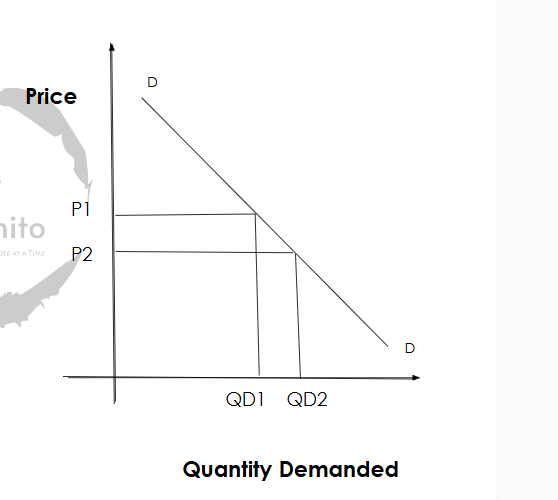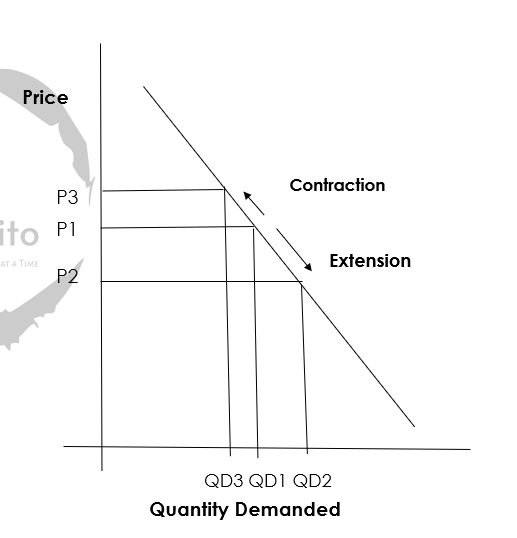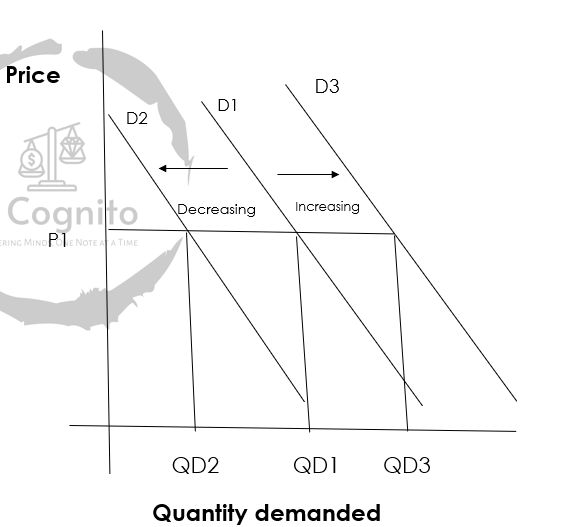2.1.1 – Demand, Price and Quantity
The definition of Demand
Demand is the Willingness, Desire and Ability to buy a good at a specific Price, Quantity and Time
*You must mention these 6 words for the definition of demand
The law of demand

Credits to: savemyexams
Whenever there is an increase in price of a good, the demand for that good will decrease, or if there is a decrease in price of a good, the demand of a good will increase. Ceteris Paribus.
The demand curve
A demand curve is a graphical representation of the relationship between the price of a good or service and the quantity demanded for a given period of time. Its typically downward sloping
The demand curve diagram will always have ‘Price’ on the Y axis and ‘Quantity demanded’( henceforth referred to as ‘QD’) on X axis.
Points where the values of ‘Price’ and ‘QD’ meet are plotted to make the demand curve, which is labelled as ‘D’ or ‘D1’
When we draw it, we tend to make it as a straight line as this is much simpler and easy to understand. [Practically the curve will indeed be a curve.]
However for exams you will be ok with drawing a straight line for the ‘curve’
{In the graph we can see that due to a price decrease from P1 to P2 there has been a QD increase of QD1 to QD2}
Movements along the demand curve

Credits to: savemyexams
There are 2 types of movements along the curve, Extension and contraction.
These will only happen if a change in the price of the good is reason behind the change in demand.
Extension: A extension in demand means the demand extends[increases] due to a reduction in price [change in Price P1 to P2 has caused an extension in demand]
Contraction: A contraction in demand means the demand contracts[decreases] due to a increase in price[change in Price P1 to P3 has caused a contraction in demand]
These changes occur due to the law of demand; if price increases demand contracts/ if price decreases demand extends.
Individual and Market Demand
Individual demand is the demand for a good in a particular period of time by a single customer, Market demand is the sum of all Individual demands in the same period of time. Ceteris Paribus.
Say for hats, when hats are 10$, Customer A demands 10, B demands 3 and C demand 7, but when hats are 7$ customer A demands 13, B demands 7, C demands 12.
We can say that at Price of 10$ the market demand is 20 {10+3+7}
The individual demands are 10, 3, 7
And at Price of 7$ the market demand is 32 {13+7+12}
Individual demands are 13,7,12
The substitution effect, Law of diminishing marginal utility and Income effect
| The income effect | The law of diminishing marginal utility | The substitution effect |
| This refers to the change in consumers purchasing power due to a change in the price of a good. | Marginal utility is the extra satisfaction or benefit a consumer gets from consuming additional units of a product or service. | This suggests that consumers will seek out the good that is more competitive/affordable; they will substitute goods that have become more expensive with ones that are more affordable |
| If Price decreases then purchasing power of consumers increase as they can buy more of the good with the same amount of money. Vice Versa | This law assumes the utility from the first/prior consumed unit is more than the unit consumed after it. Ceteris Paribus. | So this assumes consumers are rational decision makers; make decisions that are the best for them, and have perfect information and will adjust their consumption based on prices |
| The income effect assumes that consumers adjust consumption patterns according to price of goods | Thus firms try to keep prices lower to make their offer more attractive and make the consumer purchase additional goods. |
2.1.2 Non-Price determinant factors of demand
There are 2 types of factors that affect demand, Price and Non Price factors, we have already seen price, which is the only Price factor.
However there are several non price factors;
Population: Or the amount of consumers, more the consumers higher the demand
Disposable Income: The amount of untaxed income a consumer has to spend, the more disposable income they have the more demand there will be
Tastes and Preference/Popularity: The trends in the world; if frameless glasses are becoming more popular/coming into fashion the demand for them will increase
Pricing of Substitutes : substitutes are goods that are interchangeable; if the prices of coffee increase, the demand for tea will increase as its a substitute to coffee. Connect with law of demand
Pricing of complementary goods: Complementary goods are goods that go hand in hand; if the prices of petrol increase the demand of cars is likely to decrease as its a complementary good to petrol. Connect with law of demand
Future expectations: future expectations of price of a product, if price is expected to rise in future demand will increase currently, vice versa. Connect with law of demand
Weather: If the weather favours a good, its demand will increase; demand for sweaters increase in winters.
The shifts in demand curve

Credits to: savemyexams
A shift in demand curves occurs due to a change in demand influenced by any of the non price factors.
This means there is a completely new demand curve in addition to the original curve.
A increase in demand is illustrated by a rightwards shift of the original demand curve, a decrease in demand is illustrated by a leftward shift.
Notice how even with demand changing the price stayed the same; this means a non price factor has caused the change in demand.
D1->D2= Decreasing demand[lefts shift]
D1->D3= Increasing demand[right shift]
